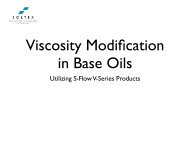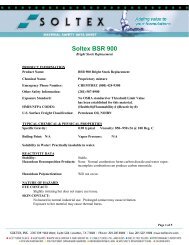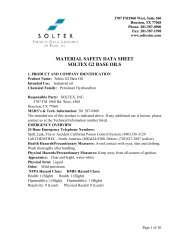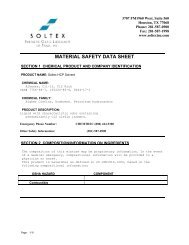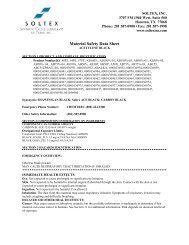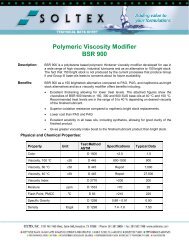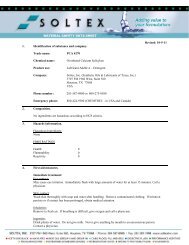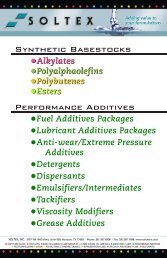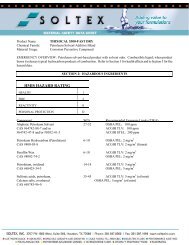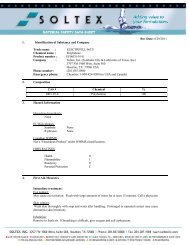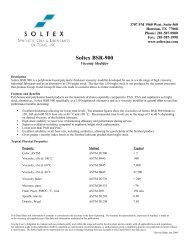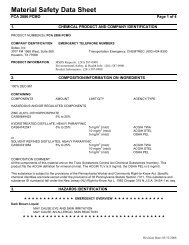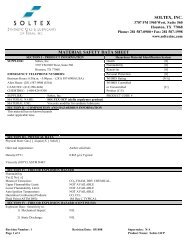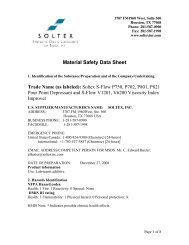The Application and Use of Soltex Products in Hydrocarbon ...
The Application and Use of Soltex Products in Hydrocarbon ...
The Application and Use of Soltex Products in Hydrocarbon ...
You also want an ePaper? Increase the reach of your titles
YUMPU automatically turns print PDFs into web optimized ePapers that Google loves.
<strong>The</strong> <strong>Application</strong> <strong>and</strong> <strong>Use</strong> <strong>of</strong> <strong>Soltex</strong><br />
<strong>Products</strong> <strong>in</strong> <strong>Hydrocarbon</strong> Lubricants<br />
<strong>and</strong> Lubrication Systems –<br />
Lubrication Technology<br />
1
Lubrication Technology<br />
• Function <strong>and</strong> purpose <strong>of</strong> the lubricant<br />
• Hydrodynamic lubrication<br />
• Boundary lubrication<br />
• Extreme pressure (EP) lubrication<br />
2
Lubricant Function <strong>and</strong> Purpose<br />
• Keep mov<strong>in</strong>g parts apart<br />
• Reduce friction<br />
• Protect aga<strong>in</strong>st wear<br />
• Transfer heat<br />
• Transfer power<br />
• Remove dirt <strong>and</strong> debris <strong>in</strong> conjunction<br />
with detergent/dispersant/filtration<br />
3
Reduce Friction <strong>and</strong> Wear<br />
• Some wear always occurs even <strong>in</strong> a fully<br />
lubricated system<br />
• Amount <strong>of</strong> wear depends on lubrication regime<br />
• Lubrication regime is determ<strong>in</strong>ed by the load<br />
on the mov<strong>in</strong>g parts<br />
• Higher loads result <strong>in</strong> higher lube temperatures<br />
<strong>and</strong> <strong>in</strong>creased friction <strong>and</strong> wear<br />
4
Hydrodynamic Lubrication<br />
• Characterized by very low wear <strong>and</strong> low friction<br />
• (Friction is resistance to movement between<br />
two surfaces.<br />
• Operates at low loads<br />
• <strong>The</strong> oil forms a hydrodynamic wedge that fully<br />
separates the surfaces beyond the level <strong>of</strong> the<br />
surface asperities<br />
• At higher loads the hydrodynamic wedge<br />
breaks down <strong>and</strong> metal to metal contact results<br />
5
Hydrodynamic Lubrication<br />
• Hydrodynamic lubrication is a primarily a<br />
function <strong>of</strong> the viscosity <strong>of</strong> the lubricant<br />
• Higher viscosity oils are better hydrodynamic<br />
lubricants than th<strong>in</strong>ner oils<br />
• However lubricant viscosity must be balanced<br />
aga<strong>in</strong>st <strong>in</strong>creased energy requirement<br />
• Trend is lower viscosity, energy efficient oils<br />
6
Boundary Lubrication<br />
• To meet the dem<strong>and</strong>s <strong>of</strong> more energy efficient<br />
oils, lubrication other than hydrodynamic is<br />
required<br />
• As the hydrodynamic wedge breaks down with<br />
<strong>in</strong>creas<strong>in</strong>g load, temperatures at the metal<br />
surface <strong>in</strong>creases<br />
• Boundary lubrication <strong>in</strong>volves the addition <strong>of</strong><br />
certa<strong>in</strong> additives to the base oil that under the<br />
conditions <strong>of</strong> <strong>in</strong>creased surface temperature<br />
can comb<strong>in</strong>e with the metal surface to form a<br />
mono-molecular layer.<br />
7
Boundary Lubricants<br />
• Boundary lubricants are compounds that consist <strong>of</strong> a long<br />
hydrocarbon tail <strong>and</strong> a polar head group<br />
• <strong>The</strong> polar head group attaches to the metal surface<br />
• Important to note; this is an electrostatic attraction <strong>and</strong><br />
not a true chemical reaction<br />
• <strong>The</strong> long hydrocarbon tail projects out from the metal<br />
surface <strong>and</strong> provides a lubricat<strong>in</strong>g mono-molecular that<br />
prevents metal to metal contact <strong>and</strong> reduces wear<br />
8
Boundary Lubricants<br />
• As long as the “oil like” hydrocarbon tail is<br />
attached to the metal surface it can’t be<br />
squeezed out as is the case with the<br />
hydrodynamic wedge<br />
• <strong>The</strong> mono-molecular film has the lubricat<strong>in</strong>g<br />
properties <strong>of</strong> a base oil but is more permanent<br />
<strong>and</strong> not dependent on viscosity<br />
• It is critical that the layer be mono-molecular –<br />
ball bear<strong>in</strong>g effect<br />
9
Boundary Lubricants<br />
• In general the polar head group is provided by either<br />
organo-metallic compounds or compounds <strong>of</strong> oxygen or<br />
nitrogen or both<br />
• Metallic compounds are usually <strong>of</strong> the cationic type i.e.<br />
organic salts <strong>of</strong> calcium or magnesium or molybdenum<br />
• Compounds <strong>of</strong> nitrogen or oxygen are non-ionic <strong>and</strong> are<br />
usually reaction product derivatives <strong>of</strong> maleic anhydride<br />
with PIB to give PIB succ<strong>in</strong>ic anhydrides (PIBSA) <strong>and</strong> PIB<br />
succ<strong>in</strong>ic imides (PIBSI)<br />
• <strong>The</strong> choice <strong>of</strong> cationic or non-ionic type depends on the<br />
formulation <strong>and</strong> possible <strong>in</strong>teractions with other additives<br />
10
Boundary Lubricant Mechanism<br />
• Lube base-stocks are typically non-polar<br />
• <strong>The</strong> rule <strong>of</strong> thumb is that “like dissolves like” so lube<br />
base-stocks would have tendency to dissolve additives<br />
that are non-polar<br />
• However boundary lubricants necessarily need to have a<br />
polar end to attach to the metal surface<br />
• <strong>The</strong> long hydrocarbon cha<strong>in</strong> associated with the boundary<br />
lubricant provides solubility <strong>in</strong> the base-oil<br />
• <strong>The</strong>refore s<strong>in</strong>ce the boundary lubricant is soluble <strong>in</strong> the<br />
base-stock it always available to the surface to replenish<br />
<strong>and</strong> ma<strong>in</strong>ta<strong>in</strong> the mono-molecular layer<br />
11
Extreme Pressure (EP) Lubrication<br />
• At even higher loads boundary lubrication also<br />
breaks down allow<strong>in</strong>g metal to metal contact<br />
<strong>and</strong> rapidly <strong>in</strong>creas<strong>in</strong>g wear<br />
• Surface temperatures dramatically <strong>in</strong>crease<br />
• EP additives added to the lubricant base-stock<br />
react with the metal surface to form new metal<br />
compounds<br />
• Results <strong>in</strong> harder metal surface<br />
12
EP Additives<br />
• All EP additives conta<strong>in</strong> the elements <strong>of</strong> S or P<br />
or Zn ( sometimes Mo) or comb<strong>in</strong>ations <strong>of</strong> all<br />
• EP additives also have long cha<strong>in</strong> hydrocarbon<br />
groups but only serve as carrier to afford<br />
solubility <strong>of</strong> the additive <strong>in</strong> the base-stock<br />
• High surface temperatures are required to<br />
<strong>in</strong>itiate the additive reaction with the metal<br />
surface<br />
• Characterized by high <strong>in</strong>itial wear (break-<strong>in</strong>)<br />
13
Other Lubricant Functions<br />
• Fully formulated lubricant which consists<br />
<strong>of</strong> base-stock plus additives<br />
• Prevent wear <strong>and</strong> reduce friction as<br />
discussed, but also;<br />
• Transfer heat<br />
• Transfer power<br />
• Remove dirt <strong>and</strong> debris <strong>in</strong> conjunction<br />
with detergent/dispersant/filtration<br />
14



